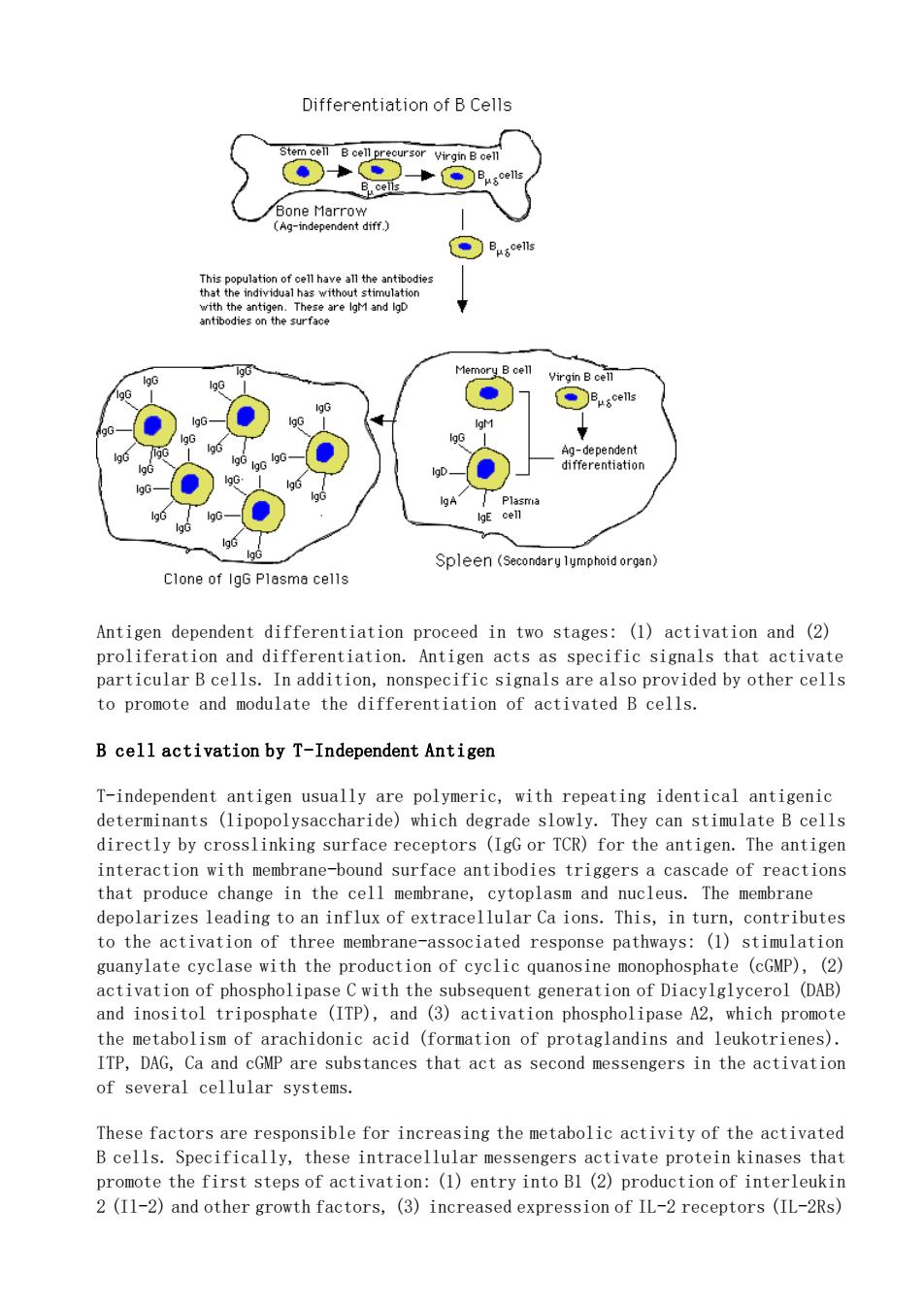正在加载图片...

Differentiation of B Cells 6onerharaaid amp Virgin B cell Clone of lgG Plasma cells Antigen dependent differentiation proceed in two stages:(1)activation and (2) proliferation and differentiation.Antigen acts as specific signals that activate particular B cells.In addition,nonspecific signals are also provided by other cells and modulate the differentiation of activated B cells. B cell activation by T-Independent Antigen T-independent antigen usually are polymeric,with repeating identical antigenic determinants (lipopolysaccharide)which degrade slowly.They can stimulate B cells directly by crosslinking surface receptors(IgG or TCR)for the antigen.The antigen interaction with membran e-bo und surface antibodies triggers a cascade of reactions that produ ange in the cell membrane, cytoplasm and nucleus.The membran depolarizes leading to an influx of extracellular Ca ions.This,in turn,contributes to the activation of three membrane-associated response pathways:(1)stimulation guanylate cyclase with the production of cyclic quanosine monophosphate (cGMP),(2) activation of phospholipase c with the subsequent generation of diacyiglycerol (Dab) and inositol triposphate (ITP),and(3)activation phospholipase A2.which promote the metabolism of arachidonic acid(formation of protaglandins and leukotrienes) ITP,DAG,Ca and cGMP are substances that act as second messengers in the activation of several cellular systems. These factors are responsible for increasing the metabolic activity of the activated promote the first steps of activatic 2(I1-2)and other growth factors,(3)increased expression of IL-2 receptors (IL-2Rs)Antigen dependent differentiation proceed in two stages: (1) activation and (2) proliferation and differentiation. Antigen acts as specific signals that activate particular B cells. In addition, nonspecific signals are also provided by other cells to promote and modulate the differentiation of activated B cells. B cell activation by T-Independent Antigen T-independent antigen usually are polymeric, with repeating identical antigenic determinants (lipopolysaccharide) which degrade slowly. They can stimulate B cells directly by crosslinking surface receptors (IgG or TCR) for the antigen. The antigen interaction with membrane-bound surface antibodies triggers a cascade of reactions that produce change in the cell membrane, cytoplasm and nucleus. The membrane depolarizes leading to an influx of extracellular Ca ions. This, in turn, contributes to the activation of three membrane-associated response pathways: (1) stimulation guanylate cyclase with the production of cyclic quanosine monophosphate (cGMP), (2) activation of phospholipase C with the subsequent generation of Diacylglycerol (DAB) and inositol triposphate (ITP), and (3) activation phospholipase A2, which promote the metabolism of arachidonic acid (formation of protaglandins and leukotrienes). ITP, DAG, Ca and cGMP are substances that act as second messengers in the activation of several cellular systems. These factors are responsible for increasing the metabolic activity of the activated B cells. Specifically, these intracellular messengers activate protein kinases that promote the first steps of activation: (1) entry into B1 (2) production of interleukin 2 (Il-2) and other growth factors, (3) increased expression of IL-2 receptors (IL-2Rs)